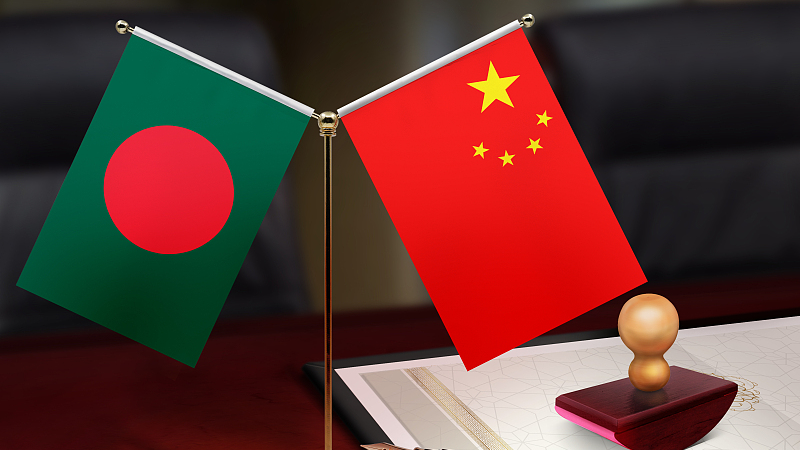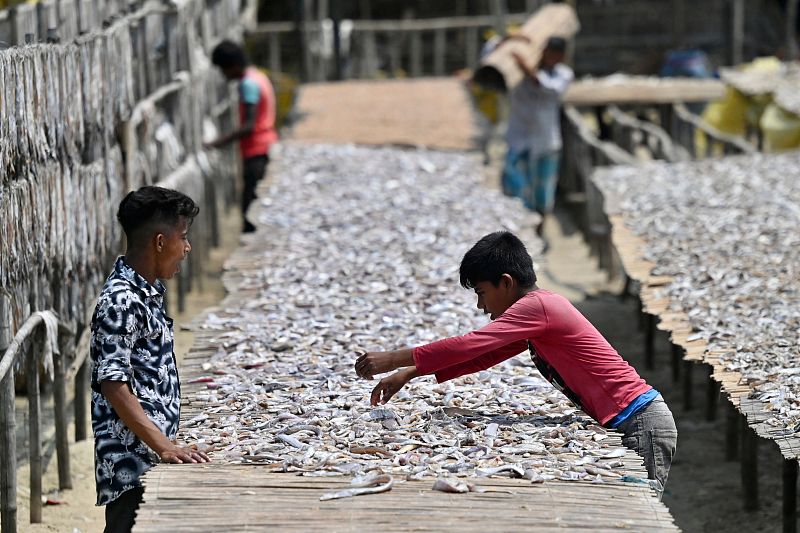
National flags of Bangladesh and China. /CFP
National flags of Bangladesh and China. /CFP
Editor's note: Abu Naser Al Farabi is a Dhaka-based columnist and analyst focusing on international politics, especially Asian affairs. The article reflects the author's opinions and not necessarily those of CGTN.
On August 6, Chinese State Councilor and Foreign Minister Wang Yi came to Bangladesh as a part of his regional tour. During his two-day visit, he met with his Bangladeshi counterpart Foreign Minister AK Abdul Momen and paid a courtesy call to Prime Minister Sheikh Hasina.
His visit to Bangladesh carries huge significance, given the ongoing crisis in Taiwan Strait, having been inflamed immediately after the U.S. House of Representative Speaker Nancy Pelosi's provocative trip to the region, and growing China-U.S. geopolitical tensions with sizeable impacts on developing countries like Bangladesh.
On August 2, in disregard of China's strong opposition and serious reprehension, Nancy Pelosi visited China's Taiwan region. Just days after Pelosi's visit to Taiwan, the Foreign Ministry of Bangladesh issued a statement on its official Facebook page reiterating Bangladesh's firm adherence to its long-standing commitment to the one-China principle.
Emphasizing Bangladesh's firm commitment to the one-China principle, State Minister for Foreign Affairs Md Shahriar Alam said that this stance is nothing new since Bangladesh always supports the one-China principle.
It is worth mentioning that months after winning the 2008 election, the then-administration led by the current Prime Minister Hasina closed the Taipei business representative office in Dhaka in response to the request from China and in line with its long-standing commitment to the principle. Since then, China-Bangladesh bilateral engagement has been deepening on multiple dimensions – ranging from investment to trade to cultural cooperation and exchange.
Bangladesh is now one of the fastest-growing emerging economies in the world with an economic size of around $416 billion. With a poverty rate of 44.2 percent in 1991, its per capita GDP stands today at more than $2,503 – with the poverty rate declining to 20.5 percent.
In Bangladesh's development journey, China has played a substantial role, particularly since 2009. One of the major bottlenecks to its development endeavor was the country's huge infrastructural gap, notably in the energy, power, and transport sectors.
China invested about $9.75 billion in Bangladesh from 2009 to 2019, promising to be further boosted by Chinese President Xi Jinping's visit to Bangladesh in 2016 – which pledged to invest $40 billion in Bangladesh in line with China's Belt and Road Initiative (BRI). Such unflinching infrastructural investment support to Bangladesh has been contributing to bridging the country's long-overdue infrastructure gap, thereby propping up the border infrastructural developments of the South Asian region.
Chinese Foreign Minister's recent visit to Bangladesh is expected to "elevate the relationships to a new level." Upon his visit, both countries signed or renewed four MoUs on disaster management, infrastructure, cultural cooperation, and marine science. China is the topmost trading partner of Bangladesh, with bilateral trade now standing at a staggering $25.15 billion. To facilitate Bangladesh's import to China, which is about $1 billion, China, during Wang Yi's visit, has announced duty-free access to 99 percent of Bangladeshi goods and services, raising from the existing 98 percent.

Children sort fish at a fish processing area in Bangladesh, March 25, 2022. /CFP
Children sort fish at a fish processing area in Bangladesh, March 25, 2022. /CFP
During his visit, Bangladesh sought cooperation from China to repatriate more than one million Rohingya refugees. China has been trying to bring a diplomatic resolution to the crisis and had brokered the bilateral diplomatic deal between Bangladesh and Myanmar to repatriate the Rohingya refugees in 2018. Given the fact that the prolonged stay of Rohingyas here is worsening the law-and-order situation in Bangladesh, and threatening the country's socio-economic stability, Bangladeshi people earnestly expect China to assist Bangladesh more in sending Rohingya refugees back to Myanmar. Wang Yi in his visit also assured of continuing Chinese support to that end.
Both China and Bangladesh share a unique commonality in their experience with national development. With around 80 percent of Chinese people living in poverty just back in the 1980s, China is now the second largest economy in the world, lifting more than 800 million people out of poverty within the span of four decades.
Bangladesh has also gone through a similar experience, from a flood-prone poor country to now the 41st economy in the world. China's astonishingly multidimensional development experiences that begin to profoundly enmesh with Bangladesh's development endeavors with growing bilateral engagement since 2009 could deliver more experimental energy to our ongoing development efforts.
In Bangladesh's long-aspired journey to being an upper-middle-income country, China was and will always be with Bangladesh. Wang Yi's recent visit has elevated that mutual trust further.
(If you want to contribute and have specific expertise, please contact us at opinions@cgtn.com. Follow @thouse_opinions on Twitter to discover the latest commentaries in the CGTN Opinion Section.)

